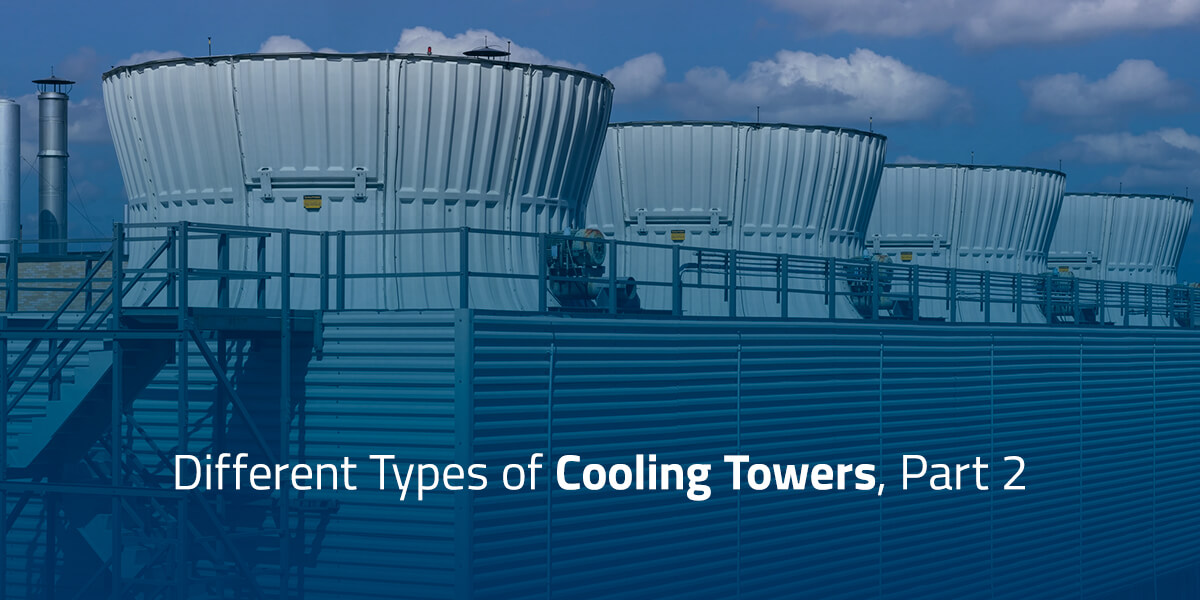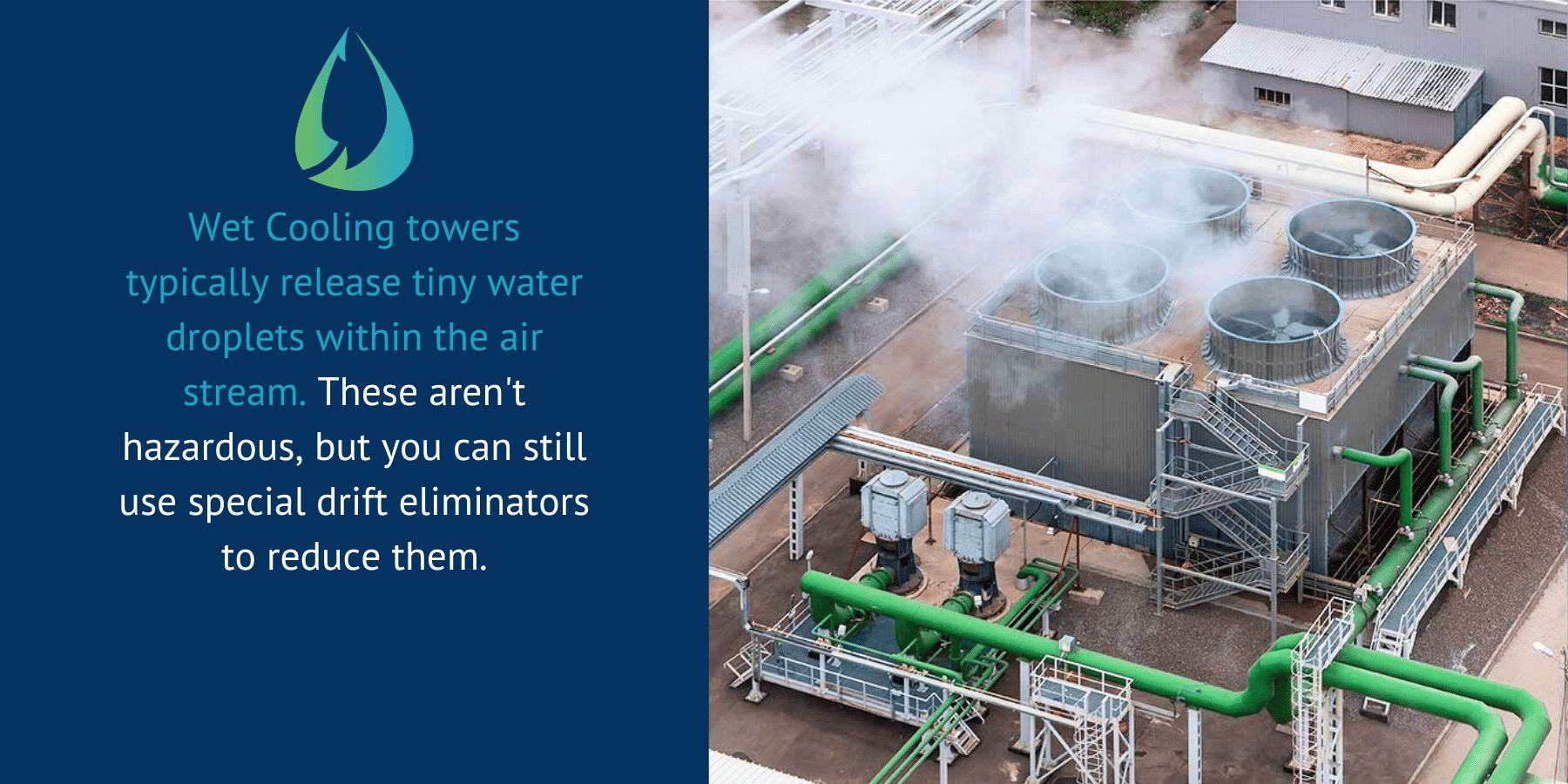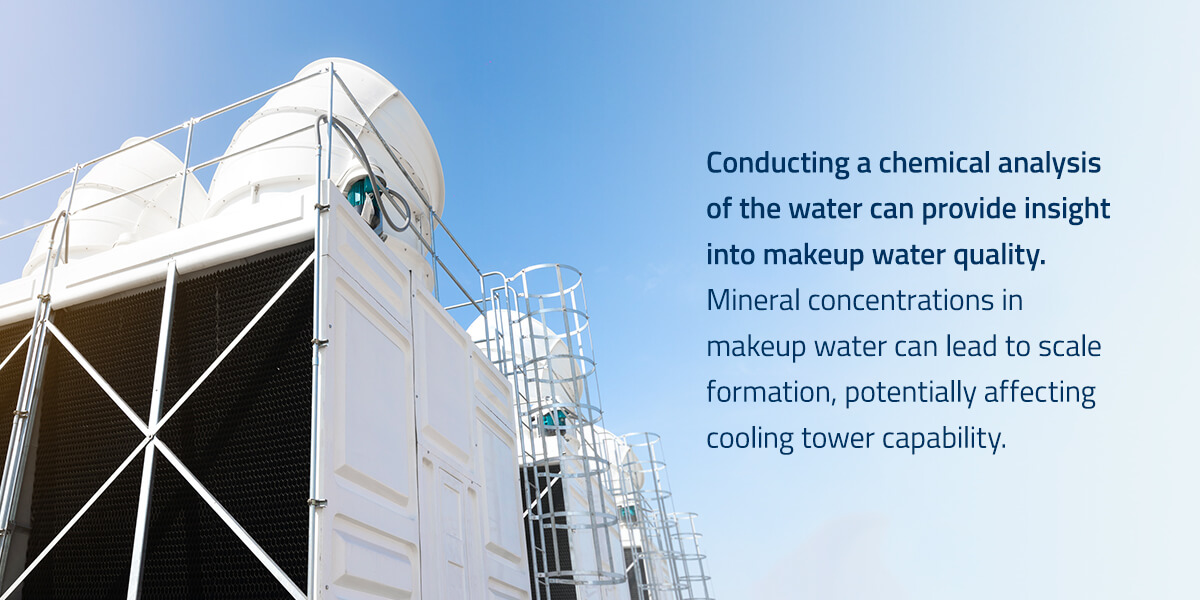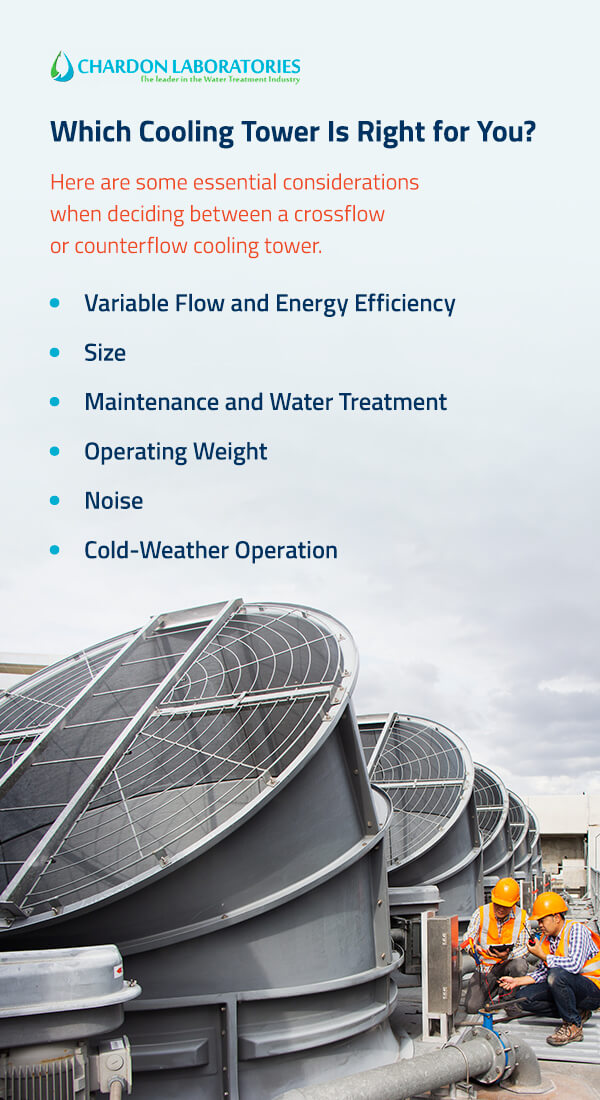
July 12, 2023
A cooling tower is a device that brings water and air into contact with each other, pulls heat from the water, then sprays cold water down through the tower. It provides large-scale air conditioning for a building. You’ll find cooling towers in many manufacturing facilities, health care settings, food processing organizations and power plants.
Multiple cooling tower styles use different heat transfer methods. In this second part of our guide to the different types of cooling towers, we’ll discuss heat transfer techniques, the differences between crossflow and counterflow cooling towers, ways to determine cooling tower efficiency and more.
A cooling tower is a heat exchanger that withdraws heat from the water through direct contact. Heat exchange occurs through the evaporation of a small portion of the water.
This evaporation reduces the temperature of the water circulating through the tower. The evaporated water and heat flow through the top of the tower as a fine mist. The cool water accumulates in a basin, then gets released back into the facility or plant for reuse.
There are four primary types of heat transfer methods.

As the name implies, wet or open-circuit cooling towers use water to cool facilities. The following factors measure heat transfer in a wet cooling tower:
Wet cooling towers typically release tiny water droplets within the air stream. These aren’t hazardous, but you can still use special eliminators to reduce them. Open-circuit cooling towers are affordable, cost-effective, renewable and efficient, making them popular for various facilities.
A dry cooling tower runs on an electric motor, which separates the working fluid from the ambient air to transfer heat. It doesn’t use any water, hence the name. There are two kinds of dry cooling towers.
A fluid cooling tower mixes water with glycol, creating a fluid that travels through a coil. The fluid cools down as it circulates. While closed-circuit towers require more horsepower to achieve cooler temperatures, they offer high productivity and low downtime. They are ideal for surfaces that must be free of contamination.
A hybrid cooling tower switches between dry and wet cooling operations to reduce water consumption. It balances water and energy savings to reduce its environmental impact. Air travels through the wet section before moving to the dry upper section.
The air from the dry and wet sections rises and mixes above the fan. This action results in little to no visible water vapor discharge.
Induced draft cooling towers use mechanical systems like fans to move cool air. Below are two common types of induced draft cooling towers.
In a crossflow tooling tower, air travels horizontally through the system while hot water flows downward from distribution basins. Crossflow cooling towers use small pumps, making them cost-effective and straightforward to maintain.
Additionally, their non-pressurized spray enables more variable water flow. Essentially, variable flow or “turndown” is the effectiveness of cooling tower capacity for a given process flow.
However, crossflow towers tend to be less efficient and more prone to freezing than counterflow towers. Their fill can also become clogged with dirt and debris, especially in dusty, sandy and windy locations.
In a counterflow cooling tower, air moves in the opposite direction of the falling water. In other words, air moves upward while water travels downward to cool the air.
Counterflow towers provide long-term energy-saving benefits. They tend to be more efficient because they’re more compact than their crossflow counterparts. Their spray distribution provides more freezing resistance. The spray volume’s large surface area also allows for more economical heat transfer.
However, counterflow cooling towers require larger pumps to push air, increasing energy use and utility bills. Additionally, they often experience less variable water flow than crossflow cooling towers.
To determine which type of cooling tower is more productive, it first helps to understand these two factors.
Finding the range and approach can help determine the cooling tower’s efficiency. Fundamentally, cooling tower efficiency is the percentage of water temperature cooldown against the difference between hot water temperature and wet-bulb temperature. The formula is Cooling Tower Efficiency = Range / (Range + Approach) x 100.
Here are other strong indicators of cooling tower productivity.

Maximum cycles of concentration largely depend on local water quality. Therefore, knowing the makeup water compositions is critical to determine a cooling tower’s efficiency. Conducting a chemical analysis of the water can provide insight into makeup water quality. Mineral concentrations in makeup water can lead to scale formation, potentially affecting cooling tower capability.
The formula for makeup water quality is Makeup Water = Blowdown + Evaporation Loss + Drift Loss.
To address any scale buildup, a cooling tower water treatment specialist can flush the highly mineral-concentrated portion of the water down the drain, then replace it with fresh water. This process is cooling tower bleed-off or blowdown.
As mentioned, makeup water composition contributes to optimal cycles of concentration in cooling tower water. To find COC, you calculate the ratio of the blowdown water’s concentration of dissolved solids compared to makeup water. You can calculate COC using the following formulas.
The less makeup water in a cooling tower, the better. You might assume higher COC values indicate a more efficient cooling tower. However, a higher COC for the same amount of makeup water can increase the chance of heat transfer components scaling and fouling. The ideal COC balances makeup water requirements and heat transfer quality.

Crossflow and counterflow cooling towers have their pros and cons. Ultimately, your site conditions and requirements will determine the appropriate cooling tower for your building.
So, what is the optimal cooling tower for your facility? Here are some essential considerations when deciding between a crossflow or counterflow cooling tower.
With federal and state energy efficiency requirements at play, a cooling tower with good turndown is ideal for increasing energy savings.
You can boost cooling tower capacity in a few ways, such as increasing the tower’s footprint, height or fan motor horsepower. Due to their water distribution techniques, crossflow towers generally have better variable flow than counterflow cooling towers.
Cooling towers require different air volumes to exchange heat in process water, resulting in various sizes and configurations. You’ll need to consider your facility’s available space and the cooling tower size and height it can accommodate. A tall cooling tower may pose complications if your site has height restrictions.
Air and water interact vertically in a counterflow cooling tower. At cooling capacities of no more than 750 tons, a counterflow tower’s vertically stacked elements may require less physical space than a crossflow cooling tower. However, a counterflow cooling tower will likely occupy more space than a crossflow tower when capacities exceed 750 tons.
Depending on the application, a crossflow tower may require less space than a counterflow tower, even at heat loads below 750 tons. Primarily, this is because a crossflow tower has two air inlets, while a counterflow tower has four. Your facility’s height limitations and other space requirements will determine the importance of physical cooling tower size.
Regular maintenance is essential to maintain cooling tower efficiency and extend its service life. Therefore, maintenance accessibility is another critical consideration when selecting a cooling tower. The ease of access to internal components often varies between crossflow and counterflow cooling towers.
In a crossflow tower, fill material surrounds the tower’s exterior portions. The tower has a tall, easily accessible plenum space, allowing you to inspect and service the motor, fan, drive system, drift eliminators and cold water basin. When working with a larger crossflow cooling tower, you can opt for a preinstalled ladder and platform to access the motor and drive.
On the other hand, a counterflow cooling tower’s overhead horizontal material creates a barrier between internal components, making maintenance access more challenging. While the operator may reach the cold water basin easily, accessing the motor, spray system, fan, eliminators and dry system is a different story because these components are above the horizontal fill.
A crossflow tower has an inherently larger footprint, making its shipping and operating weight higher than a counterflow cooling tower. The crossflow tower’s steel casing, additional structural supports and piping for water distribution also contribute to its larger footprint.
With counterflow cooling towers, lighter-capacity cranes are usually necessary to lift individual vertically stacked components. You’ll need to weigh the potential logistical and crane savings against the need for additional picks per cell.
Cooling towers can generate high noise pollution levels, subjecting them to rigorous regulations. Organizations must abide by these laws to keep cooling tower noise at bay. Noise control is especially vital in settings like medical facilities, offices and residential buildings, making it challenging to manage applications that produce large loads.
Primary sources of cooling tower noise include fans, motors, airflow and falling water droplets hitting the collection basin. If excessive noise is a concern in your facility, consider these solutions.
Additionally, remember that counterflow cooling towers tend to be noisier than crossflow towers, as the water falls farther from the bottom of the fill into the collection basin.
Cold-weather performance is critical, particularly when selecting a cooling tower for subfreezing conditions. Ice development poses a tremendous threat to cooling towers. Large ice blocks add significant weight to the tower’s structure and components, increasing the risk of collapse and damage.
Crossflow cooling towers tend to perform well in cold weather. Their gravity-fed distribution systems can disperse water evenly across the fill, even in low turndown situations. Uniform distribution helps prevent ice formation, scale buildup, water channeling, temperamental performance and tower damage. Using devices like dams or cups in the hot-water basin can help mitigate ice accumulation during cold-weather operations.
In low turndown circumstances, counterflow cooling towers have fewer nozzles and less head pressure, resulting in uneven water distribution across the fill. Inconsistent distribution can lead to issues like ice development, water channeling and scale formation.
Integrating louvers into your cooling tower can prevent splash-out that could turn to ice in subfreezing conditions. There is no external surface to stimulate ice formation.
Regardless of the cooling tower you choose, proper maintenance is essential to optimize performance, reliability and longevity. Choose a water treatment specialist like Chardon Labs to assist you. Our ISO-certified service technicians provide various cooling tower services, including:
We want to help you keep operating costs down and efficiency in full swing. That’s why we sell clean systems instead of chemicals. Rather than frequently spending money on chemicals to treat your water systems, let us handle everything instead.
Make Chardon Labs your trusted provider to see the benefits of chemical water treatment for your cooling tower. Contact us today to learn more!